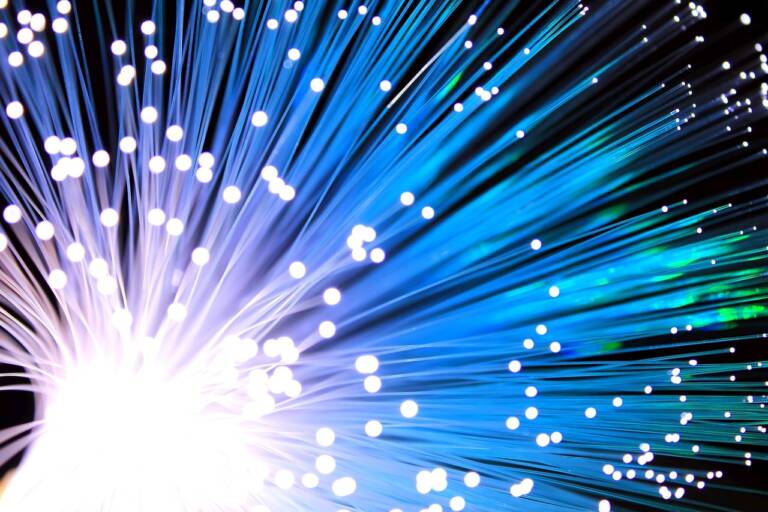Internet 4.5 million times faster, using our own fiber optics. A new discovery allows it

In a revolutionary new development, researchers at the University of Aston (UK) have achieved Internet data transmission speeds that are as much as 4.5 million times faster than the average home broadband. This unprecedented speed is the fastest ever recorded, achieved through the use of new, specific wavelength bands that have not previously been used in fiber optic systems.
As part of an international collaboration , the team transferred data at a speed of 301 terabits per second, or 301,000,000 megabits per second, using a single standard optical fiber. To put this into perspective, the UK Home Broadband Performance Report, published in September 2023, states that the average broadband speed is just 69.4 Mbit/s.
Behind the discovery
The successful data transmission was the result of collaboration between Professor Wladek Forysiak of the Aston Institute of Photonic Technologies and Dr. Ian Phillips. They worked in collaboration with researchers at the National Institute of Information and Communications Technology (NICT) in Japan and Nokia Bell Labs in the United States.
As the demand for data increases, this new technology is expected to help keep up with future demand. The scientists used fiber optics, small tubular strands of glass that transmit information using light, a medium that ordinary copper cables can't match in terms of speed.
The new technology, however, allows us to accelerate the speed of sending data even compared to the technologies normally used in optical fibers and this is the real innovation.
The science behind speed
The team achieved this feat by opening up new wavelength bands that are not yet used in regular fiber optic systems for the Internet. Different wavelength bands equate to different colors of light transmitted along the optical fiber. They achieved this by developing new devices called optical amplifiers and optical gain equalizers to access these bands.
Dr. Phillips led the development of a management device, or optical processor, at Aston University. He explained: “Broadly speaking, data was sent over an optical fiber, like an internet connection at home or in the office. However, in addition to the commercially available C and L bands, we used two additional spectral bands, called E band and S band. These bands were traditionally not needed because C and L bands could provide the capacity required to meet consumer needs.” .
“In recent years Aston University has developed optical amplifiers that operate in the E-band, adjacent to the C-band in the electromagnetic spectrum, but around three times wider. Prior to the development of our device, no one had been able to properly emulate E-band channels in a controlled manner ,” added Phillips.
Future implications for the Internet
Professor Forysiak added: “By increasing transmission capacity in the backbone network, our experiment could lead to significantly improved connections for end users.” This groundbreaking achievement highlights the crucial role of advancing fiber optic technology in revolutionizing communications networks for faster and more reliable data transmission.”
“Increasing system capacity by using more of the available spectrum – not just the conventional C-band, but also other bands such as L, S and now E – can help keep operating costs low. provision of this bandwidth. It is also a 'greener solution' and, above all, much more economical, compared to the use of more recent fibers and cables, as it makes greater use of the existing fiber network, increasing its capacity to transport data and prolonging its useful life and commercial value."
The transition to this hyper-fast internet system would also be quite simple, because it would be enough to replace the modems, which encode data for optical fibers, rather than having to change existing cables or operating systems.
The results of this groundbreaking experiment have been published by the Institute of Engineering and Technology and will be presented as a post-deadline paper at the European Conference on Optical Communication (ECOC) in Glasgow, October 2023. This result not only represents a significant leap forward in data transmission technology, but also sets a new benchmark for future research in this field.
With this technology it will be possible to respond to the demand for more data deriving from the application of IoT and artificial intelligence. Now the challenge becomes reducing the energy consumption necessary for data processing, a real constraint that still exists in the sector.

Thanks to our Telegram channel you can stay updated on the publication of new Economic Scenarios articles.
The article Internet 4.5 million times faster, using our own optical fibers. A new discovery allows this comes from Economic Scenarios .
This is a machine translation of a post published on Scenari Economici at the URL https://scenarieconomici.it/internet-45-milioni-di-volte-piu-veloce-usando-le-nostre-stesse-fibre-ottiche-una-nuova-scoperta-lo-permette/ on Thu, 28 Mar 2024 10:00:05 +0000.
